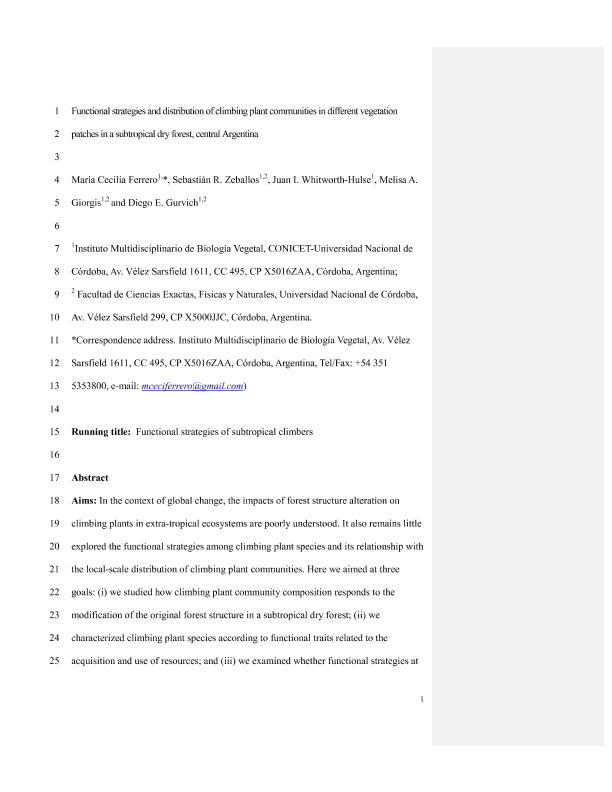Artículo
Functional strategies and distribution of climbing plant communities in different vegetation patches in a subtropical dry forest, central Argentina
Ferrero, María Cecilia ; Zeballos, Sebastián Rodolfo
; Zeballos, Sebastián Rodolfo ; Whitworth Hulse, Juan Ignacio
; Whitworth Hulse, Juan Ignacio ; Giorgis, Melisa Adriana
; Giorgis, Melisa Adriana ; Gurvich, Diego Ezequiel
; Gurvich, Diego Ezequiel
 ; Zeballos, Sebastián Rodolfo
; Zeballos, Sebastián Rodolfo ; Whitworth Hulse, Juan Ignacio
; Whitworth Hulse, Juan Ignacio ; Giorgis, Melisa Adriana
; Giorgis, Melisa Adriana ; Gurvich, Diego Ezequiel
; Gurvich, Diego Ezequiel
Fecha de publicación:
10/2017
Editorial:
Oxford University Press
Revista:
Journal Of Plant Ecology-uk
ISSN:
1752-9921
e-ISSN:
1752-993X
Idioma:
Inglés
Tipo de recurso:
Artículo publicado
Clasificación temática:
Resumen
AimsIn the context of global change, the impacts of forest structure alteration on climbing plants in extra-tropical ecosystems are poorly understood. It also remains little explored the functional strategies among climbing plant species and its relationship with the local-scale distribution of climbing plant communities. Here we aimed at three goals: (i) we studied how climbing plant community composition responds to the modification of the original forest structure in a subtropical dry forest; (ii) we characterized climbing plant species according to functional traits related to the acquisition and use of resources; and (iii) we examined whether functional strategies at the community level are also responding to vegetation structure change, a much less addressed topic in the ecology of climbing plants.MethodsThe study was carried out in the Chaco forest of Córdoba Mountains, central Argentina. We selected 18 patches of "native forests?, "shrublands" and "Ligustrum lucidum forests". We counted and identified climbing plant individuals in each patch, including woody and herbaceous species. For each species, we measured ten functional traits: leaf area, leaf area ratio, leaf dry matter content, leaf tensile strength, specific leaf area, stem density, wood saturated water content, internode length, petiole length and plant cover. We compared climbing plant composition, richness and abundance among the three vegetation types. Then, we assessed trends of functional variation of climbing plant species by performing a principal component analysis. Finally, we investigated whether simple mean, weighted mean and Functional Richness index of PCA axes differed among the climbing plant communities of the three vegetation types.Important FindingsMultivariate analysis revealed that climbing plant composition of native forests significantly differed from that of shrublands and L. lucidum forests. Also, L. lucidum forests had the lowest climbing plant species richness. Functional variation of climbers was explained by three PCA axes: axis 1 represented the resource-use strategy, axis 2 was associated with light-foraging strategy, and axis 3 related to plant size. The most abundant species in native forests presented a more acquisitive functional strategy and larger sizes than those of shrublands and L. lucidum forest. Furthermore, the most abundant species in shrublands had shorter internodes and petioles than the most abundant climbers of the other vegetation types. Finally, the climbing plant community in the native forests had the highest Functional Richness index regarding the resource-use and the size strategies. Here, we demonstrated that there are floristic and functional differences among climbing plant communities in patches of three vegetation types in a subtropical dry forest biome. Particularly, we found climbers spreading along three functional axes which were directly related to climbing plant community distribution among the different patches, highlighting their ecological importance and the need of further research
Palabras clave:
Enredaderas
,
Chaco Serrano
,
Caracteres Funcionales
Archivos asociados
Licencia
Identificadores
Colecciones
Articulos(IMBIV)
Articulos de INST.MULTIDISCIPL.DE BIOLOGIA VEGETAL (P)
Articulos de INST.MULTIDISCIPL.DE BIOLOGIA VEGETAL (P)
Citación
Ferrero, María Cecilia; Zeballos, Sebastián Rodolfo; Whitworth Hulse, Juan Ignacio; Giorgis, Melisa Adriana; Gurvich, Diego Ezequiel; Functional strategies and distribution of climbing plant communities in different vegetation patches in a subtropical dry forest, central Argentina; Oxford University Press; Journal Of Plant Ecology-uk; 10-2017
Compartir
Altmétricas



